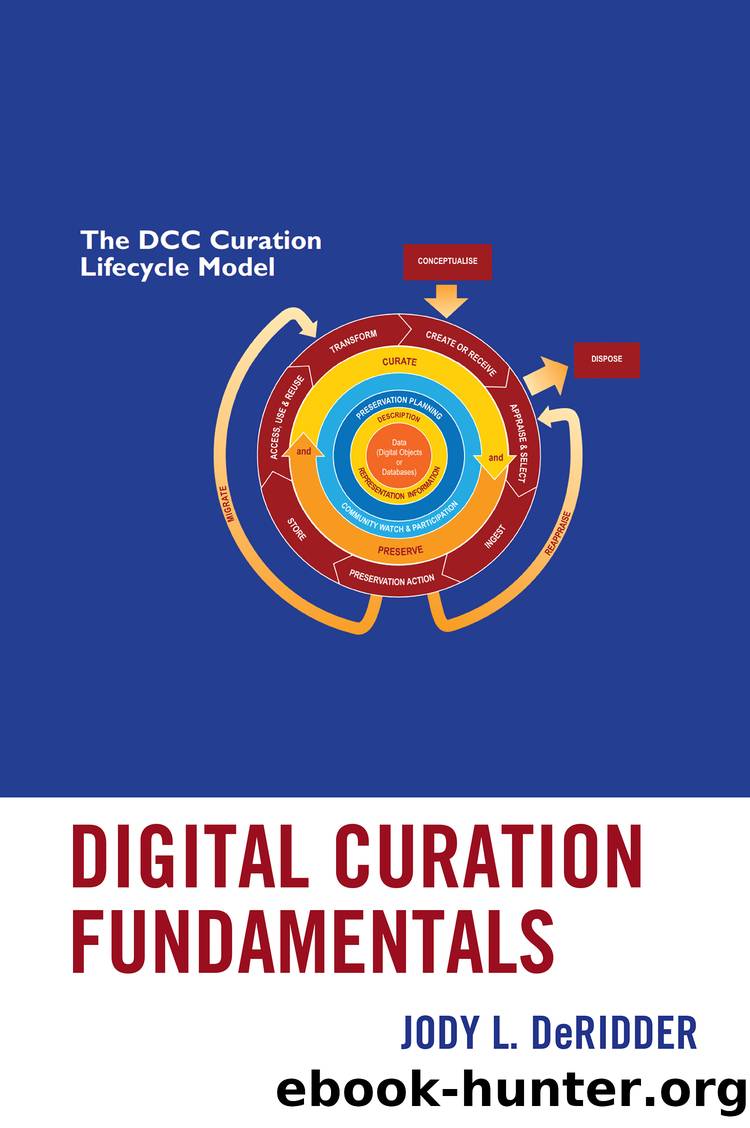Digital Curation Fundamentals by Jody L. DeRidder

Author:Jody L. DeRidder [DeRidder, Jody L.]
Language: eng
Format: epub
Publisher: Rowman & Littlefield Publishers
Published: 2018-08-02T00:00:00+00:00
Options and Methods
We all want to make sure weâre doing everything we feasibly can to address these risks to our precious digital content. Concern in the digital preservation community led to the development of a 2002 report clarifying what a âtrusted digital repositoryâ (TDR) should encompass.6 In January 2007, a group of four preservation institutions agreed on ten basic characteristics for digital preservation repositories. In brief, they are that the repository does the following:
commits to maintaining the content for their identified target audiences
demonstrates the ability to fulfill its commitment
meets required contractual and legal rights and responsibilities
has an effective set of policies
obtains digital content based on the criteria that match its commitments and abilities
maintains the integrity, authenticity, and usability of the content
creates and maintains the appropriate metadata, including that of provenance
fulfills the required dissemination of content
has a strategic preservation planning and action program
has the technical infrastructure necessary to carry out these tasks, including security7
This set of guidelines was followed by the publication of a checklist8 by which the repositoryâs compliance could be judged, and in 2012, a variation of this checklist9 became an International Organization for Standardization standard.10 At the time of this writing, only six repositories have been certified by the Center for Research Libraries as having TDRs: Canadiana.org, Chronopolis, CLOCKSS, Hathitrust, Portico, and Scholars Portal.11 Storing your content in an existing TDR would be ideal; however, digital curators are recommended to use the checklist as a guide and for comparison to identify areas in which they need to improve their own methods.
If you want a simpler set of guidelines against which you can compare your efforts, consider the National Digital Stewardship Alliance Levels of Digital Preservation (see table 7.1).12 They create four progressive stages of implementation for storage, file fixity checking, security, metadata, and file formats ranging from simple basics to full support. The following is a brief and practical overview of what best practice guidelines involve.
The best methods of storage involve multiple copies in geographically diverse locations, preferably on different types of hardware and software systems. If disaster occurs in any one location, other copies still exist, and if hardware or software systems fail, not all copies will be damaged or lost. One of the lowest-cost methods of implementing this type of storage is by participating in a community that is implementing the Stanford-developed LOCKSS software, which stands for âLots of Copies Keep Stuff Safe.â13 LOCKSS is the underlying software used by the CLOCKSS Trusted Digital Repository, which stores e-journals and e-books. In this software, copies of each institutionâs content are stored by all the nodes in the network, and the software checks for any changes in the content provided by the owning institution. Examples of private LOCKSS networks for cultural heritage materials include the Alabama Digital Preservation Network,14 which lowers costs by having partners involved in the process itself, and the MetaArchive Cooperative.15 Each of these groups openly shares their models so that they may be emulated elsewhere, and both are open to new members.
Download
This site does not store any files on its server. We only index and link to content provided by other sites. Please contact the content providers to delete copyright contents if any and email us, we'll remove relevant links or contents immediately.
Cecilia; Or, Memoirs of an Heiress — Volume 1 by Fanny Burney(32433)
Cecilia; Or, Memoirs of an Heiress — Volume 2 by Fanny Burney(31866)
Cecilia; Or, Memoirs of an Heiress — Volume 3 by Fanny Burney(31850)
The Great Music City by Andrea Baker(31319)
We're Going to Need More Wine by Gabrielle Union(18967)
All the Missing Girls by Megan Miranda(15560)
Pimp by Iceberg Slim(14376)
Bombshells: Glamour Girls of a Lifetime by Sullivan Steve(13971)
Talking to Strangers by Malcolm Gladwell(13218)
Norse Mythology by Gaiman Neil(13204)
Fifty Shades Freed by E L James(13157)
For the Love of Europe by Rick Steves(12917)
Mindhunter: Inside the FBI's Elite Serial Crime Unit by John E. Douglas & Mark Olshaker(9186)
Crazy Rich Asians by Kevin Kwan(9164)
The Lost Art of Listening by Michael P. Nichols(7403)
Enlightenment Now: The Case for Reason, Science, Humanism, and Progress by Steven Pinker(7227)
The Four Agreements by Don Miguel Ruiz(6618)
Bad Blood by John Carreyrou(6543)
Weapons of Math Destruction by Cathy O'Neil(6139)
